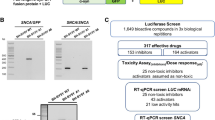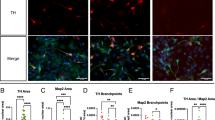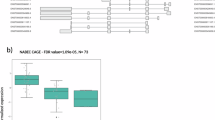Abstract
Alpha-synuclein (SNCA) is a major risk gene for Parkinson’s disease (PD) and increased SNCA gene dosage results in a parkinsonian syndrome in affected families. Regulatory regions relevant for SNCA expression include the 3′ untranslated region (UTR), which among other regulatory elements contains several micro-RNA-binding sites. Interestingly, variants located in the 3′ region of SNCA have been associated with PD in two genome-wide association studies. To test whether private mutations in this region contribute to PD, we sequenced the 3′UTR of SNCA in 1285 PD patients and 1120 age/sex-matched healthy controls. We found two rare variants, the one corresponding to the single nucleotide polymorphism rs145304567 and the novel variant c.*1004_1008delTTTTT. Although rs145304567 affects the putative-binding site of microRNA (miRNA) -433, the allele distribution was similar in PD patients and controls, and the expression of SNCA mRNA was not related to the genotype. Furthermore, a regulatory effect of miRNA-433 on SNCA expression levels was not detected.
Similar content being viewed by others
Log in or create a free account to read this content
Gain free access to this article, as well as selected content from this journal and more on nature.com
or
References
Spillantini MG, Schmidt ML, Lee VM, Trojanowski JQ, Jakes R, Goedert M : Alpha-synuclein in Lewy bodies. Nature 1997; 388: 839–840.
Braak H, Del Tredici K, Rub U, de Vos RA, Jansen Steur EN, Braak E : Staging of brain pathology related to sporadic Parkinson's disease. Neurobiol Aging 2003; 24: 197–211.
Singleton AB, Farrer M, Johnson J et al: Alpha-Synuclein locus triplication causes Parkinson's disease. Science 2003; 302: 841.
Mizuta I, Satake W, Nakabayashi Y et al: Multiple candidate gene analysis identifies alpha-synuclein as a susceptibility gene for sporadic Parkinson's disease. Hum Mol Genet 2006; 15: 1151–1158.
Satake W, Nakabayashi Y, Mizuta I et al: Genome-wide association study identifies common variants at four loci as genetic risk factors for Parkinson's disease. Nat Genet 2009; 41: 1303–1307.
Simon-Sanchez J, Schulte C, Bras JM et al: Genome-wide association study reveals genetic risk underlying Parkinson's disease. Nat Genet 2009; 41: 1308–1312.
Fuchs J, Tichopad A, Golub Y et al: Genetic variability in the SNCA gene influences alpha-synuclein levels in the blood and brain. The FASEB J 2008; 22: 1327–1334.
Doxakis E : Post-transcriptional regulation of alpha-synuclein expression by mir-7 and mir-153. J Biol Chem 2010; 285: 12726–12734.
Junn E, Lee KW, Jeong BS, Chan TW, Im JY, Mouradian MM : Repression of alpha-synuclein expression and toxicity by microRNA-7. Proc Natl Acad Sci USA 2009; 106: 13052–13057.
Daniel SE, Lees AJ : Parkinson's Disease Society Brain Bank, London: overview and research. J Neural Transm Suppl 1993; 39: 165–172.
Armitage P : Tests for linear trends in proportions and frequencies. Biometrics 1955; 11: 375–386.
Herold C, Steffens M, Brockschmidt FF, Baur MP, Becker T : INTERSNP: genome-wide interaction analysis guided by a priori information. Bioinformatics 2009; 25: 3275–3281.
Chung BD, Kayserili H, Ai M et al: A mutation in the signal sequence of LRP5 in a family with an osteoporosis-pseudoglioma syndrome (OPPG)-like phenotype indicates a novel disease mechanism for trinucleotide repeats. Hum Mutat 2009; 30: 641–648.
Xu Q, Wang Y, Dabdoub A et al: Vascular development in the retina and inner ear: control by Norrin and Frizzled-4, a high-affinity ligand-receptor pair. Cell 2004; 116: 883–895.
Cardo LF, Coto E, de Mena L et al: A search for SNCA 3' UTR variants identified SNP rs356165 as a determinant of disease risk and onset age in Parkinson’s disease. J Mol Neurosci 2011; e-pub ahead of print 11 November 2011; doi:10.1007/s12031-011-9669-1.
Wang G, van der Walt JM, Mayhew G et al: Variation in the miRNA-433 binding site of FGF20 confers risk for Parkinson disease by overexpression of alpha-synuclein. Am J Hum Genet 2008; 82: 283–289.
Grundemann J, Schlaudraff F, Haeckel O, Liss B : Elevated alpha-synuclein mRNA levels in individual UV-laser-microdissected dopaminergic substantia nigra neurons in idiopathic Parkinson's disease. Nucleic Acids Res 2008; 36: e38.
Winkler S, Hagenah J, Lincoln S et al: Alpha-Synuclein and Parkinson disease susceptibility. Neurology 2007; 69: 1745–1750.
International Parkinson's Disease Genomics Consortium (IPDGC); Wellcome Trust Case Control Consortium 2: (WTCCC2): A two-stage meta-analysis identifies several new loci for Parkinson's disease. PLoS Genet 2011; 7: e1002142.
Spencer CC, Plagnol V, Strange A et al: Dissection of the genetics of Parkinson's disease identifies an additional association 5' of SNCA and multiple associated haplotypes at 17q21. Hum Mol Genet 2011; 20: 345–353.
Acknowledgements
We gratefully acknowledge Sabine Proske-Schmitz and Anne Hanke for technical support. This study was supported in part by the Intramural Bonfor Research Program of the University Bonn (UW), the Hans-Tauber Stiftung of the Deutsche Parkinson Vereinigung (dPV, UW) and the Deutsche Forschungsgemeinschaft (Wu184/9-1).
Author information
Authors and Affiliations
Corresponding author
Ethics declarations
Competing interests
Dr. Klein is supported by a career development award from Volkswagen and from the Hermann and Lilly Schilling Foundation. The other authors declare no conflict of interest.
Rights and permissions
About this article
Cite this article
Schmitt, I., Wüllner, U., van Rooyen, J. et al. Variants in the 3′UTR of SNCA do not affect miRNA-433 binding and alpha-synuclein expression. Eur J Hum Genet 20, 1265–1269 (2012). https://doi.org/10.1038/ejhg.2012.84
Received:
Revised:
Accepted:
Published:
Issue date:
DOI: https://doi.org/10.1038/ejhg.2012.84
Keywords
This article is cited by
-
Using KASP technique to screen LRRK2 G2019S mutation in a large Tunisian cohort
BMC Medical Genetics (2017)



